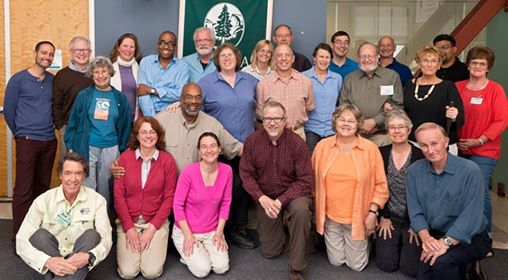I’ve never done this before but today I am attaching two articles because they are both related to our energy future.
They pretty much speak for themselves.
While the general public may not yet be thinking about the future of where their electricity will be coming from, or simply assuming that the status quo will continue, the people in the power industry are definitely thinking about it and they see that the future is about to change dramatically. This is in line with what I have been informing you about and verifies that a seismic shift is coming rapidly…in fact is already happening.
MIT unveils ‘hybrid’ device with higher efficiency, storage capability
Katherine Ling, E&E reporterPublished: Monday, January 20, 2014
Researchers at the Massachusetts Institute of Technology have developed a new approach to a technique using both light and heat that could more than double the efficiency of current solar technology.The new idea uses a hybrid of photovoltaic and solar thermal technologies by converting sunlight into heat and then back into a precise kind of light that is converted to electricity. The hybrid device has a higher efficiency like solar thermal technology, can be scaled larger or smaller like photovoltaic devices and can store energy to be dispatched when it is needed, according to the team.A top layer made of novel materials absorbs light from the entire solar spectrum, heats up close to 1,000 degrees Celsius and then emits that energy as light to a solar cell underneath it at a level that matches the photovoltaic spectrum, researchers describe in their report published yesterday in the journal Nature Nanotechnology.The new technique, known as solar thermophotovoltaic, could be more than 80 percent efficient in converting solar energy into electricity. That is a dramatic improvement on the theoretical limit of single-layer solar photovoltaic devices at 34 percent or even of stacked cells, which have a theoretical limit of 45 percent. The theoretical limit represents the percentage of the light in the total solar spectrum photovoltaic devices can absorb.While scientists have explored the thermophotovoltaic technology for some time, the MIT researchers were able to reach 3.2 percent conversion efficiency with their new device that uses carbon nanotubes and photonic crystals and other materials in its two-layer absorber-emitter device. Previous attempts had not achieved efficiency greater than 1 percent, MIT said in a statement.The new device could reach 20 percent efficiency fairly quickly, which is about the same efficiency as current commercial solar technology, according to MIT.Vast majority of power providers see shifting role by 2030
Elizabeth Harball and Nathanael Massey, E&E reportersPublished: Wednesday, October 9, 2013
Ninety-four percent of international industry representatives surveyed by PricewaterhouseCoopers (PwC) predict that the power utility business model will be either completely transformed or significantly changed between today and 2030, while only 6 percent expect that the utility business model will stay “more or less the same.”In North America, 40 percent of respondents believed that utility companies’ means of making a profit will see major changes over the next two decades. A strong majority — 82 percent — of North American respondents also said future energy needs will be met by a mix of traditional centralized generation and distributed generation, which feeds power from a mix of sources.“The power and utilities business is where banking and land line telephony were a decade or two ago, with new technologies the main driving force,” Brian Dames, chief executive of South African electricity public utility Eskom, said in an interview included in the report. “Technology advancements, especially in distributed generation and energy efficiency, will have a definite impact on existing business models.”But unlike the telecommunications sector, which was transformed overnight by the advent of fiber optics and other technologies, the progress of distributed generation technology is likely to be more incremental.“The way I characterize it is, we’re in for an evolution, not a revolution,” said David Etheridge, PwC’s Global Power and Utilities advisory leader.“In the world of power utilities today, we’re making fundamental changes that are impactful, but we’re talking increments,” Etheridge said. “So a power plant can be 20 percent more efficient, distributed generation can take 5 percent of the load.”How do future utilities get paid?
Technology advances are driving this transformation on a number of fronts. As new fleets of renewables have come online, the decentralized power they generate has eaten into the revenues of conventional power providers. Improvements to energy efficiency at the customer level have further eroded demand.And as highly variable sources of solar and wind power come online, utilities have been forced into an ever more active role balancing and redistributing the erratic power those sources generate.Those changes have forced many power providers to rethink their financial models, both for the present and the long-term future.“Everyone’s struggling with this question of who gets paid, and how,” said Charles Ebinger, director of the Energy Security Initiative at the Brookings Institution. “What we know is, you’ve got to start with the consumer and what the consumer wants. Then, you come up with a rate structure that will provide the service cost-competitively.”More than half of U.S. states have implemented some form of decoupling policies, essentially breaking the link between utilities’ revenue and the volume of kilowatts they produce. Under a basic decoupling setup, a utility sells power at a set rate that can be adjusted annually, by a regulator, to compensate for rising or falling sales.In Europe, and in Germany in particular, the rush to embrace renewable energy has been more disruptive for power providers. Many companies are moving aggressively to compensate for lower revenue margins by restructuring energy portfolios and searching out ways to cut costs, including downsizing.The developing world, on the other hand, continues to see a rapid build-out of fossil fuel power plants. In China and India in particular, most projections see conventional fuels — which remain the most cost-competitive in world markets — feeding the lion’s share of future demand.However, Asian respondents were even more likely than their U.S. or European counterparts to predict a widespread and disruptive transition from the traditional power sector business model. Sixty-nine percent of Asian respondents predicted a wholesale transformation by 2030, as opposed to just 46 percent in Europe and 40 percent in North America.In Asia, Etheridge said, renewables “may be a follower instead of a leader.” But ultimately the demands of a rising consumer base, as well as the ecosystem pressures that result from unbridled fossil fuel use, will drive a more sophisticated, diversified energy mix, he said.Utilities as orchestra conductors, not monopolies
It is difficult to project how distributed generation will fold into the larger grid in individual jurisdictions and how utility companies may expect to turn a profit in this environment.“It is not very likely that the current transformation of the industry will lead to one specific global utility business model,” Johannes Teyssen, CEO of German utility E.ON SE, said in the report.Today, some utilities chafe at the current net-metering arrangement, claiming that distributed generation customers are not paying their fair share for the reliable backup services provided by central power, pushing costs onto regular customers (ClimateWire, Oct. 3).But PwC’s survey respondents were surprisingly positive about the business potential of decentralized energy, with 82 percent seeing distributed generation as “an opportunity,” while only 18 percent viewed it as a “threat.”“The utilities around the country as I speak to them, they want to participate in the new economies that are going to be evolving, including the economies that evolve around distributed generation,” Etheridge said.Becoming the provider of distributed generation services will likely be a key strategy for utility companies aiming to stay profitable, the PwC report finds, with 67 percent of respondents seeing this as “likely or highly likely to be successful” in a future market no longer dominated by centralized power.“I do not believe for a minute that today’s distribution systems are going to be obsolete,” said Ralph Cavanagh, co-director of the Natural Resources Defense Council’s Energy Program.Cavanagh sees a “rich” role for utilities in an increasingly decentralized energy landscape, predicting they will be the overseers of power grid maintenance and operation, renewable energy management and storage, and new power sources and long-term investment.In order to coordinate the plethora of power sources including wind, power and cogeneration that will be available in a decentralized power landscape, “you need an orchestra conductor, a long-term investor,” Cavanagh said. Utilities, experts say, are well-positioned to step into this role.But because distributed generation is currently still largely subsidized, Etheridge noted that the technology is still a “challenging investment decision” for potential investors.“In an environment where the economics don’t work without subsidization, it’s imperative that it be known which constituency is subsidizing other constituents within that utility’s jurisdiction,” Etheridge said. “That’s a challenge that each of the utilities is having to face right now.”



